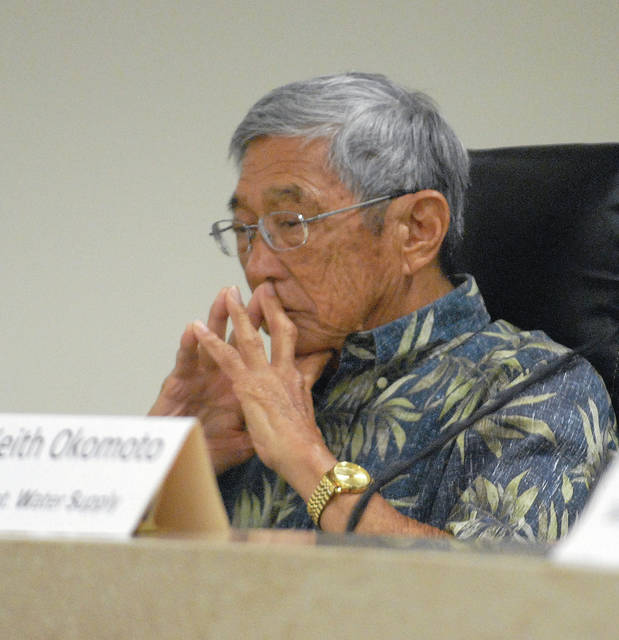KAILUA-KONA — Mayor Harry Kim did not agree with the Hawaii County Department of Water Supply’s decision to keep quiet on the failure of two North Kona deep wells in the first half of October, but he did accept it.
Kim received a call from Keith Okamoto, DWS manager/chief engineer, following the failure of the deep well at Hualalai during the first week of October — only a handful of days after its repair.
Okamoto informed Kim during that call of his intention to keep the sensitive information in-house because he deemed notification of the public “unnecessary.”
“I accept his rationale that he felt the water system was adequate,” Kim said Wednesday. “I accept the fact that the reason he was not going to release it was because he thought it (would cause) undue anxiety for the public when it was not necessary.”
“There’s a difference with accept and agree. I do not agree,” Kim continued. “Civil Defense would never do that. And this office would not do that.”
Kim added he could have forced DWS to release the information but chose not to do so because public safety was not under imminent threat.
The mayor said anytime safety is a factor, he can and will “impose his wishes” upon those departments and employees that serve the county.
After being informed of the situation by Okamoto, Kim briefed the Hawaii County Civil Defense staff on the deep well failures and Okamoto’s decision to keep the media and the public in the dark on those matters.
“We had a discussion and, you know, the Civil Defense mentality is you don’t do this,” Kim explained. “Good or bad news, to maintain trust, you’ve got to be 100 percent (open).”
The mayor said he does not believe Okamoto’s decision was an attempt to hide the truth. Kim believes instead the head of DWS was genuine in his desire to mitigate unnecessary public concern.
Still, Kim said he would have handled the situation differently in Okamoto’s position.
“I didn’t (tell Okamoto) I disapproved,” Kim explained. “I just said Civil Defense had a staff meeting and we would not do that because it’s so important to maintain the level of total truth. You want trust, then you better be 100 percent.”
DWS issued a press release on Oct. 3 indicating deep wells at the Hualalai and Palani sites had returned to functional status. The repairs left only three of North Kona’s 13 deeps wells inoperative and allowed for the rollback of water restrictions in the area to the mandatory 25 percent usage reduction that had been in place since January.
For the previous two months, DWS had mandated North Kona customers halt nearly all irrigation and utilize water only to meet basic needs of hydration, cooking and hygiene.
But as the Oct. 14 Ironman World Championship approached, bringing with it island visitors numbering in the tens of thousands, two more deep wells failed, including the deep well at Hualalai, which had finally started pumping again only days before.
For a period of at least a couple of days, as confirmed by Okamoto Tuesday, North Kona was again dealing with five inoperative wells.
Throughout the water saga that has now spanned almost a full year, five downed wells had traditionally served as the threshold for moving to a water restriction even more excessive than the mandatory 25 percent cutback — one that included mandated cuts to almost all irrigation.
That restriction was not restored at any point in October.
Shortly after the deep well at Keahuolu went offline in the second week of October, bringing the total number of inoperative wells back up to five, DWS returned the deep well at Honokohau to service. DWS has yet to provide a timeline with precise dates for well failures and repairs throughout the month of October.
The Honokohau deep well is one of the system’s anchor wells and can pump water both north and south to customers with ease, meaning it’s more valuable than the average North Kona water source.
The department did not notify the media or the public of any of these developments until the afternoon of Oct. 31, a few hours after a West Hawaii Today reporter placed an inquiry to DWS as to the status of ongoing well repairs.



